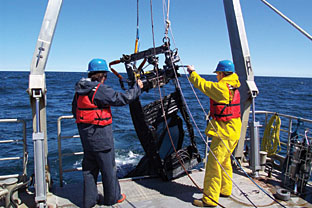
![]()
Volume 7, No. 3
Promoting Cooperation to Maintain and Enhance
Environmental Quality in the Gulf of Maine
|
||||||||||
|
|
|
|
|
|
|||||||
|
|
|
|
Browse the archive |
|
|
|
|
Project monitors harmful plankton to safeguard coastal health
By Rebecca Love
To understand and predict the complex dynamics of planktonic communities in the western Gulf of Maine, scientists in New Hampshire have created an ecosystem monitoring program to predict harmful algal bloom occurrences in near-shore waters, based on an integrated assessment of the planktonic community.
 |
| Zooplankton samples are taken using a Multiple Opening-Closing Net and Environmental Sensing System (MOCNESS)–an electronically-guided plankton net. Photo courtesy of COOA |
REACH is one of five seed projects associated with the University of New Hampshire Center of Excellence in Coastal Ocean Observation and Analysis (COOA), led by Dr. Janet Campbell, research professor of earth sciences at UNH. The data collected by REACH and other COOA-supported projects, Campbell says, will be archived and made available to aid scientists as well as resource managers, port authorities, fishing and tourism agencies, public health officials and marine weather forecasters and non-profit environmental organizations.
The project’s principal investigator, Dr. Ann Bucklin, a professor of zoology at UNH and the director of New Hampshire Sea Grant, says REACH is a departure from the traditional single-species assessment toward a broader ecosystem analysis.
“Phytoplankton and zooplankton communities are diverse and complex, and difficult to characterize without detailed counting of individual species,” Bucklin explains. “We are seeking a rapid community-level indicator or assessment measure that will become a usual element in monitoring ecosystem health in coastal waters.”
For a year now, scientists have monitored plankton communities via monthly sampling cruises on UNH’s RV Gulf Challenger along a transect six to 12 miles off Portsmouth. Zooplankton samples are taken using a Multiple Opening-Closing Net and Environmental Sensing System (MOCNESS)–an electronically-guided plankton net that samples vertical slices through the water column. Water samples measure nutrients, chlorophyll and phytoplankton species. Vertical profiles of temperature and salinity are taken at each station to characterize the physical properties and structure of the water column.
Planktonic communities serve as important indicators of ecosystem health. In general, coastal waters serve as an interface region between river runoff from estuaries and the open ocean. This high-impact, sensitive boundary area is influenced both by human activities and by a suite of complex oceanographic processes. In return, these waters can directly impact coastal communities by harboring blooms of toxic phytoplankton, known as harmful algal blooms, or HABs.
The HABs that occur in the Gulf of Maine are caused by dinoflagellates, from the genus Alexandrium. These single-celled organisms live in oceans, estuaries, lakes, and ponds. Seasonal fluctuations in nutrient levels in the water can cause population explosions in many species of dinoflagellate. The toxins that are produced by these dinoflagellates accumulate in shellfish and other filter-feeding animals–a problem called paralytic shellfish poisoning (PSP). The PSP toxins (accumulated in shellfish) can also affect animals higher in the food web such as fish, marine mammals and humans. PSP causes serious economic problems (due to shellfish bed closures) and health problems (including a potentially fatal neurological disorder).
REACH’s intensive examination of New Hampshire’s coastal waters is complemented by programs in neighboring states. For example, the Cape Cod Bay Monitoring Project, led by the Center for Coastal Studies in Provincetown, Massachusetts, is analyzing the planktonic community and nitrogen content near the Boston Harbor sewage outfall, 9.5 miles offshore into Massachusetts Bay.
Other programs sample Maine and Rhode Island coastal waters. Another COOA seed project, Coastal Marine Primary Production Observing System, is developing maps showing the distribution of oceanic production in coastal waters using remotely-sensed and field data.
Eventually, the findings from these and other coastal monitoring efforts will be integrated and compared to assess the inter-connectedness, or distinctiveness, of New Hampshire’s coastal waters.
Rebecca Love is an oceanographer and writer who spent the past year collecting plankton samples in the western Gulf of Maine as part of REACH. Visit the Center of Excellence in Coastal Ocean Observation and Analysis at www.cooa .unh.edu/.